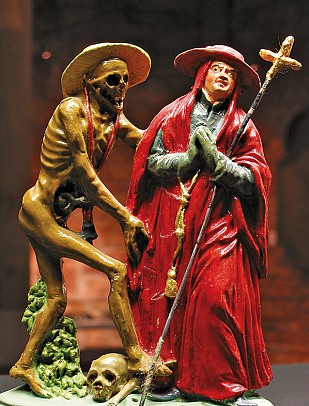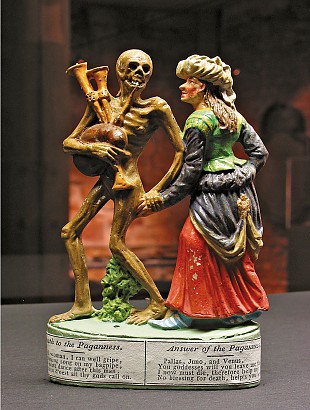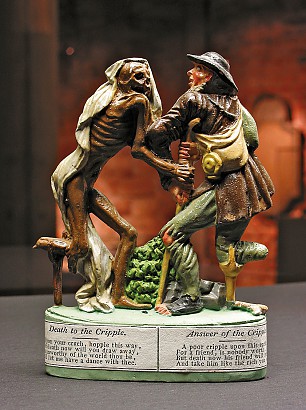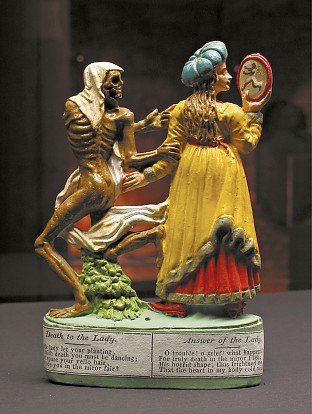The Zizenhausen Dance of Death
Death comes for everyone!
Der Zizenhausener Totentanz (3 main motifs 39 pairs)
Anton Sohn and descendatns (GER, 1769 – 1840)
manufactured from 1822; clay, oil paint, paper
Well, this object is not hidden in the depths of the depot, but can be seen permanently in our exhibition – but it is so exciting that it gets a place for its story here once again. The figures of the Totentanz series have all been brought into the museum as part of a sales promotion. Local institutions and citizens have purchased the 42 figures and lent them to the museum on a permanent basis.
Wrapped in his red robe, the cardinal has folded his hands in prayer; his gaze is raised to the sky. Next to him, a so-called skin skeleton jumps over a skull lying on the ground. He invites the Cardinal - whom the skeleton seems to cheekily imitate through a yellow cardinal's hat – to dance. The cardinal realizes that despite his power in this world, he has to follow death just like everyone else. These two clay figures are part of a series of 42 pairs of figures, the so-called Zizenhausen Totentanz. The models for these clay figures were created in 1822/23 by Anton Sohn (1769-1841) who worked in Zizenhausen near Stockach, Germany.
In 2004, the Museum for Sepulchral Culture was able to purchase a series with English texts throughout. This "Kassel Series" has since been added to our collection. Although there was great international interest in the figures, it is unfortunately not known how long this interest lasted, how many figures (or even series) were sold and to whom. Today complete series are almost impossible to find. But every now and then single pairs of figures can be assigned to an artist and a time. Although every series of the Zizenhausen Dance of Death is unique because it is painted by hand, the exceptionally well-preserved "Kassel Series" is a special rarity. And it is the only known English series at present.
Whoever is interested in researching this unique piece will find it in a lot of technical literature and also in our catalogue "Auf Tod komm raus".

Photo: Frank Hellwig
© Museum für Sepulkralkultur, Kassel, Bildarchiv
The history of the Zizenhausener figures
The motif of the Dance of Death, which was popular in Europe from the 15th century onwards and was initially probably treated primarily in literature, later served as a model for the visual arts. The motif of dance was represented either by long dance chains or by jumps and musical instruments. While at first dead people – marked as so called "Hautskelette" (skin skeletons) – invited the individual members of the profession to dance, it was later the personified death itself – as a real skeleton – that surprised the members of the profession in their everyday work. The dance with the dead became an encounter with death. Dances of death – no matter what form it takes – make it clear that in the face of death all people are equal and that spiritual or worldly power and wealth are of no use.
One of the most famous Totentänze was the so-called Basler Totentanz, a two-metre high mural painting on the cemetery wall of the preacher's monastery in Basel, created around 1440. Over a length of about 60 metres, it presented 39 pairs of dances of death and the three leitmotifs "Adam and Eve", the "preacher scene" and the "charnel house". Unfortunately, art lovers were only able to save a few fragments of the Basel Dance of Death, which was destroyed in 1805; 19 of these are now in the Historical Museum of the City of Basel.
The Zizenhausen figures can be regarded as evidence of the lasting effect of the Basel Dance of Death and the great interest in it, even after its destruction. The figures are named after the district of Stockach in Baden-Württemberg, where Anton Sohn lived since 1799 and produced and sold the popular clay figurines. Secular motifs such as groups in traditional costume or children's scenes were particularly popular with tourists and the local population. After the famous Basel Dance of Death was destroyed in 1805, Sohn took on the production of small replicas. From 1823 on, 42 groups of figures could be purchased. The front side of the pairs of figures was formed into a round shape, while the back side remained unprocessed. After firing in a ceramic kiln, they were painted by hand with oil paint –usually over a chalk primer – and details were even refined with gold leaf. On the pedestal is a strip of text written or printed with the Dance of Death verses. These texts have been translated into several languages – probably because of the increasing tourism.
The figures from the Totentanz series were produced by the Sohn family for over 150 years. Therefore it is also possible that figures of different series sometimes differ strongly from each other.

Photo: Frank Hellwig
© Museum für Sepulkralkultur, Kassel, Bildarchiv

Photo: Frank Hellwig
© Museum für Sepulkralkultur, Kassel, Bildarchiv

Photo: Frank Hellwig
© Museum für Sepulkralkultur, Kassel, Bildarchiv
Arbeitsgemeinschaft Friedhof und Denkmal e.V.
Zentralinstitut für Sepulkralkultur
Museum für Sepulkralkultur
Weinbergstraße 25–27
D-34117 Kassel | Germany
Tel. +49 (0)561 918 93-0
info@sepulkralmuseum.de








